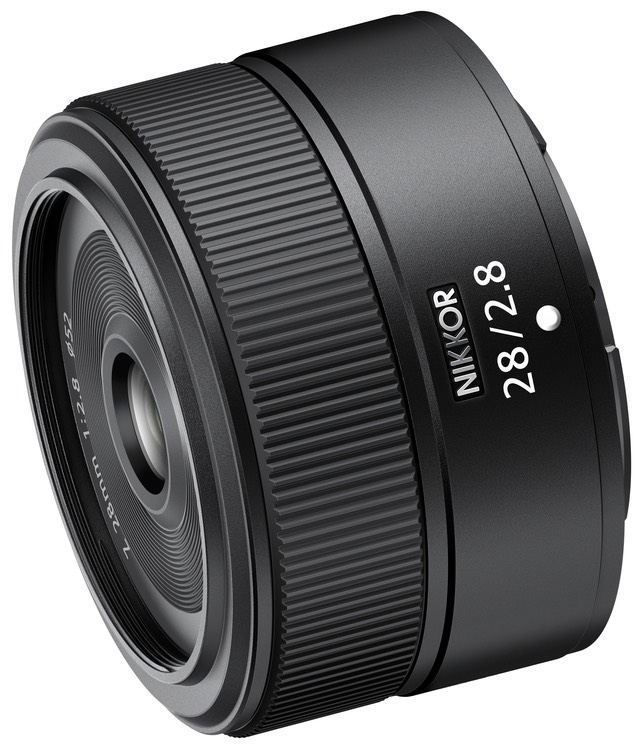
What is It?
The 28mm f/2.8 comes in two versions, a legacy-styled SE version that is a kit lens available with the Zfc camera, and the "regular" Z System style (shown above). It's a compact lens at only 2.8" (70mm) long, and a light one, too (5.5 ounces, or 155g).
Nikon Z System users have been asking for compact primes pretty much since the introduction of the Z6 and Z7, and the 28mm f/2.8 is Nikon's first response.
Optically, it's reasonably simple and somewhat old school: 9 elements in 8 groups (old school), with two of the elements being aspherical (more modern approach). Most of the glass mass is at the back of the lens. The aperture diaphragm stops down to f/16 and is electronically controlled, as with all Z-mount lenses, but has only 7 rounded blades, another simplification. No special optical coatings are used, though Nikon's ubiquitous Super Integrated Coating is present. Up front we have 52mm filter rings on an inner barrel (not at outer edge of the lens).
Surprisingly, the focus system on the lens is dual motor (stepping motor, as usual for Nikon Z-mount). Focus is internal, and has a minimum distance of 7.5" (.19m). That puts the maximum magnification ratio at a meh 1:5. While Nikon suggests that the lens doesn't focus breath for video, I could detect a small amount of change if you rack from minimum focus to infinity. For most focus moves, no, you wouldn't see any focus breathing.
Also meh is that there really isn't anything else to distinguish the lens: no switches/buttons, no extra ring, only a non-functioning silver cosmetic ring on the SE version of the lens.
Nikon not only doesn't supply a lens hood with the 28mm f/2.8, but they haven't specified one, either. Amazon has two reasonable choices: the F-Foto HF-52 and the LingoFoto HN-2 [affiliate links: As an Amazon Associate I earn from qualifying purchases].
The lens is not specifically weather sealed, though the design doesn't really have any ingress points for water. The lens mount is polycarbonate, not metal. I don't judge that to be an issue; Nikon uses a very hard polycarbonate that actually withstands wear better than some of their metals.
The 28mm f/2.8 is made in Thailand and comes in a regular version and an SE version that has a silver band and styled a bit more like legacy Nikkors. Otherwise, there is no difference between the lenses. The SE version is one of the kit lenses for the Zfc, which explains the style difference. Most Z System users would probably rather have the plain Z version, as it stylistically matches all the other Z Nikkors.
Price is US$299.
Source of the reviewed lens: purchased.
How's it Handle?
As with most of the Z System primes, there's not much to talk about. The fly-by-wire focus ring is easy to find (SE version tested) and smooth.
How's it Perform?
Focus: The two focus motor system is fast, but not completely silent. Some very low-level whirr is generally heard.

Sharpness: Very good performance from the center axis through to the DX frame area wide open, with the FX corners being fair-to-good (a little blurrier than my usual "good" but more contrasty than my usual "fair"). I'd put the weaker corner performance more due to fairly significant field curvature than to poor optical rendering, though (which sort of explains my blurry versus contrast comment). Stopping down helps the corners get more squarely into the lower good range, but they never fully tighten up. Again, I take that as being the result of field curvature while trying to render flat test targets. Distance performance is better than close-up performance with this lens.
Astigmatism is not bad. Not as good as the f/1.8 optics, but also not as bad as we were used to seeing in the F-mount primes. Coma is also higher than we've seen in the f/1.8 optics, though it gets under control as you stop down. The astigmatism coupled with the field curvature means that FX corners never really get snap (though, again, DX corners fare much, much better).
The lens does show some focus shift as you change apertures; the lens pushes the focal plane backwards as you stop down. Up through f/5.6 this isn't an issue using autofocus on the Z bodies, but be careful when using smaller apertures and closer-in distances.
Chromatic Aberration: I was a bit surprised to see clear longitudinal chromatic aberration wide open, and it's still present to a lesser degree at f/4. It's worse in the near field than the far field, which is also a bit unusual. Lateral chromatic aberration is well corrected, though.
Vignetting: Strong extreme corner vignetting, but the circle in which the vignetting is mostly ignorable is large (certainly includes the DX corners). Nikon's Vignette control does not reduce the extreme FX corners to invisibility at the default value, leaving over 1EV at the corner. But at f/4 onward you can probably leave the default set.
Linear Distortion: I was surprised to see pin-cushion distortion uncorrected. There's still a wee hint of that seen with the corrections turned on.
Flare: One of the better characteristics of the lens. There's some veiling flare at f/2.8, but ghosting artifacts on in-frame or near edge of frame lighting seems reasonably well controlled.
Bokeh: The primary issue I see is that the onion-skinning can be clearly visible in out of focus highlights, particularly the first ring as compared to the rim highlight. Very coke bottle-esqe. There's obvious rim highlight, though I didn't find that problematic as it is not taking on significant color from aberrations. Not a lot of cats eye effect is present, either, but circles don't stay circles as you stop down: they elongate some and can show aperture blade inconsistencies. That said, the focus plane to background blur transition seems very nice to me, a trait all recent Nikkors share, and the full out of focus bokeh doesn't cry out much attention to itself.
Compared to the 28mm f/2.8D: Better performance outside the central area, better CA handling, worse vignetting (without correction), better flare handling.
Final Words
Personally I find this lens unexciting in almost every way: focal length, size, optical quality, close-up performance. That doesn't mean it's a bad lens. I just don't have a need for a 28mm FX lens that performs much like a film-era lens, with field curvature, focus shift, and corner drop-off to think about. But many of you reading this will probably be happy if you liked the old f/2.8D primes.
On the DX bodies, we're at 42mm equivalent, which is at the bottom of the "normal" lens range, plus the corner issues all go away. Yes, it's somewhat better than the 16-50mm f/3.5-6.3 DX kit lens at the equivalent focal length (plus just over a stop faster), so for the time being the 28mm f/2.8 will suffice as a reasonable stand-in for a normal DX prime, even if it doesn't net you a lot in terms of ISO recovery.
The good news is that the 28mm f/2.8 is a US$300 lens, and small enough to pack with you in almost any situation. Unfortunately, I just can't quite put a "recommended" rating on it: there's just a little too much to watch for in terms of corner performance, particularly when you also have to watch out for field curvature and focus shift.
Support this site by purchasing from the following advertiser:
